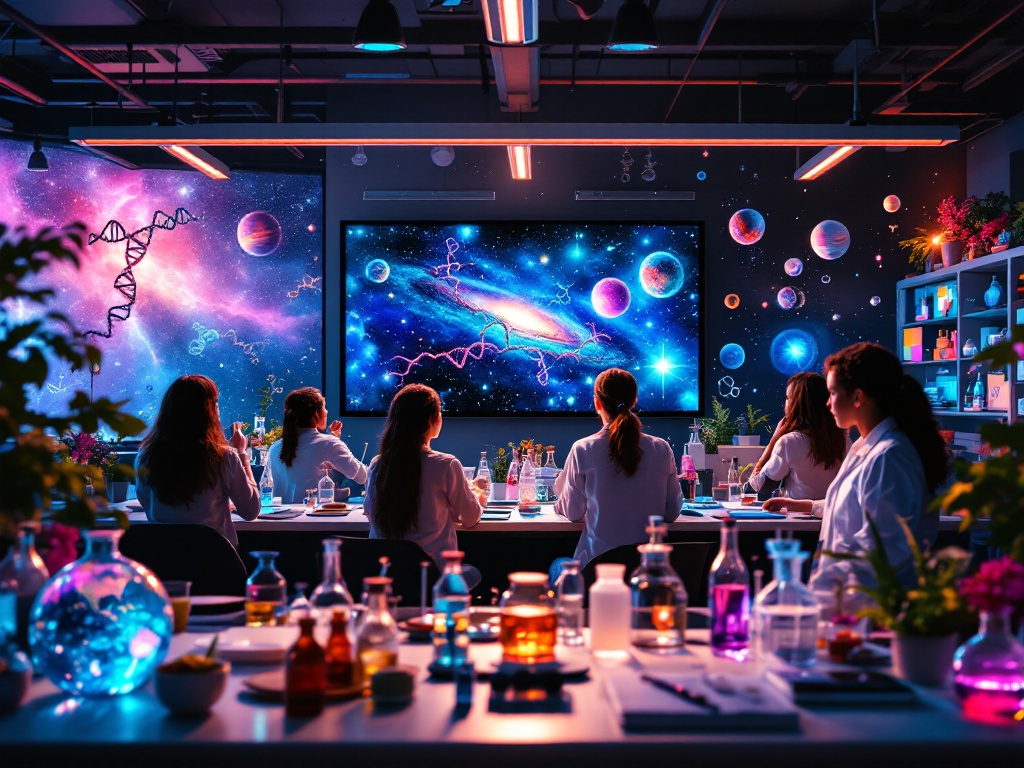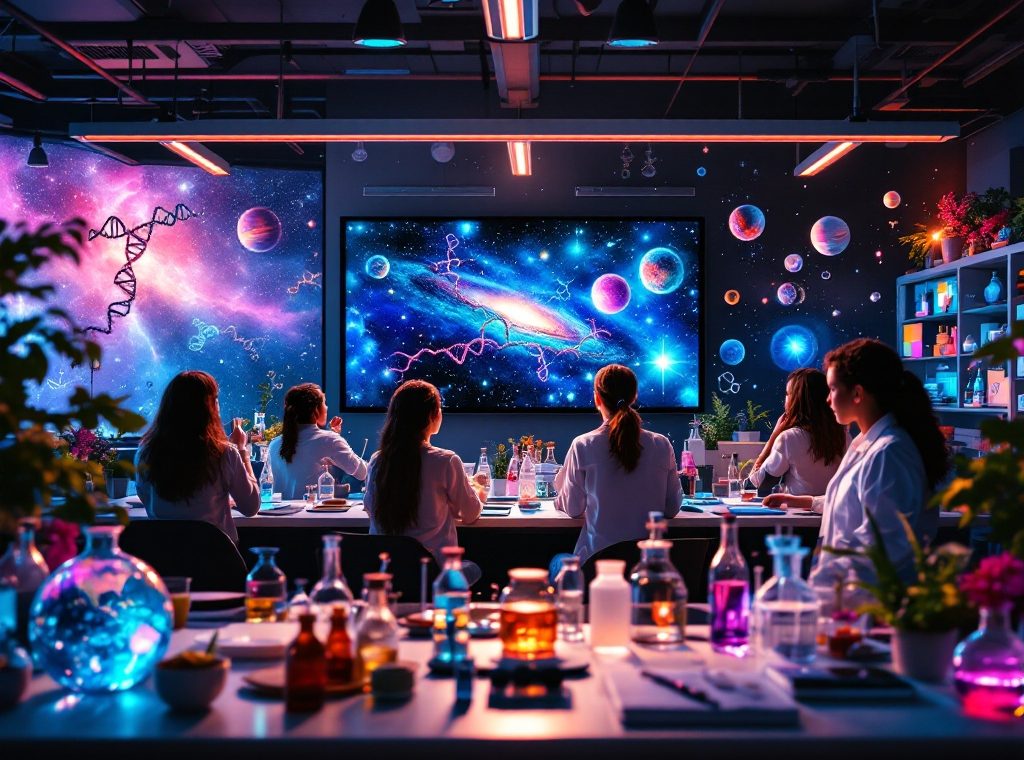The Most Interesting Science News for Students
Dive into the fascinating world of groundbreaking scientific discoveries! From CRISPR gene editing revolutionizing medicine and agriculture to the exploration of potentially habitable exoplanets, science is rapidly advancing. Explore the latest breakthroughs in space exploration, including the James Webb Telescope’s stunning images, and learn about the impact of climate change on biodiversity. Discover how mRNA vaccines offer hope in the fight against diseases like pancreatic cancer and explore the challenges of antibiotic resistance. Start your journey into the future of science now!
Important information

- Advancements in gene editing, like CRISPR, are revolutionizing medicine, agriculture, and conservation efforts.
- The James Webb Space Telescope is providing groundbreaking images and data, expanding our knowledge of the universe, including the discovery of water vapor on exoplanets.
- The 2011-2020 decade was the hottest on record, and the decline of global sea ice is accelerating global warming and impacting marine ecosystems.
- New vaccines, including mRNA vaccines for pancreatic cancer and personalized cancer vaccines, offer hope in the fight against diseases.
- Nanoparticles are transforming medicine with targeted drug delivery and improving robotics with enhanced materials and sensors.
The Most Interesting Science News for Students
Science is leaping forward, boosting renewable energy and delivering medical marvels like mRNA vaccines. We’re also uncovering how climate change impacts biodiversity. It’s a revolution! Gene editing tools like CRISPR are transforming medicine, agriculture, and conservation by enabling precise DNA modifications. The microscopic world is revealing its secrets, too. Microbiomes, tiny communities of organisms, play a crucial role in human health and disease. Space exploration continues to astound, with discoveries of potentially habitable exoplanets. Advanced rover technology is also providing detailed analyses of Martian soil. Our understanding of the cosmos is expanding, fueled by exciting observations of black holes and neutron stars, offering glimpses into the universe’s enigmatic nature.
Groundbreaking Scientific Discoveries
Scientific landmarks have revolutionized our understanding of the universe and continue to shape our future. London’s Royal Greenwich Observatory has played a crucial role in astronomy and navigation. The Einstein Tower in Potsdam stands as a testament to Einstein’s groundbreaking theories of relativity. Cambridge’s Cavendish Laboratory has significantly advanced physics, particularly in electricity and magnetism. The Galileo Museum in Florence celebrates the pioneering scientist’s legacy. CERN, home to the Large Hadron Collider, continues to probe the fundamental mysteries of particle physics.
Recent discoveries are fueling excitement in space exploration.
- Finding water on exoplanets has opened up new possibilities in the search for life beyond Earth.
- Improved Mars rover technology allows for more detailed exploration of the Martian surface.
- The James Webb Space Telescope provides unprecedented views of the universe, pushing the boundaries of our knowledge.
Beyond space, groundbreaking advancements are transforming various fields.
- Quantum computing breakthroughs promise to revolutionize computation and problem-solving.
- Progress in renewable energy offers sustainable solutions to global energy challenges.
- Rapid developments in human genetics, including CRISPR gene editing technology, are revolutionizing medicine and agriculture.
These scientific leaps are powered by cutting-edge technology. Artificial intelligence, high-throughput sequencing, and advanced imaging techniques empower researchers and shape our future.
The Power of Earthquakes: Understanding Their Impact
Earthquakes unleash tremendous power from a sudden energy release within the Earth’s crust, generating seismic waves. A powerful example is a magnitude 7.7 earthquake, whose shallow depth intensifies its impact, especially in densely populated areas. The lack of earthquake-resistant structures in these regions makes such events particularly destructive. Shallow earthquakes are more destructive than deep ones because their energy is released closer to the surface, where human populations and infrastructure are concentrated. The destructive power of a shallow, magnitude 7.7 earthquake can be amplified in densely populated areas due to the concentration of vulnerable structures. Constructing earthquake-resistant buildings is crucial for mitigating the devastating effects of these natural disasters.
De-extinction: Challenges in Bringing Species Back to Life
De-extinction, the process of reviving extinct species, presents significant scientific challenges. Reconstructing a complete genome from degraded DNA is incredibly complex. Even if a genome is successfully rebuilt, finding a viable host egg and ensuring proper embryonic development are substantial obstacles. Reintroducing a resurrected species into a changed environment carries unpredictable ecological risks and unforeseen consequences. Despite these hurdles, research into these complex issues is ongoing. The following are some key challenges:
- Genome reconstruction, reconstructing a complete genome from degraded DNA is incredibly complex,
- Host egg viability, finding a viable host egg is a substantial obstacle,
- Embryonic development, ensuring proper embryonic development is difficult,
- Ecological risks, reintroducing a resurrected species carries unpredictable ecological risks and unforeseen consequences.
Vaccine Breakthroughs: Long-term Protection Against Pancreatic Cancer
A new vaccine offers lasting protection against pancreatic cancer, a promising development from a recent clinical trial. This vaccine’s ability to provide long-term defense against this aggressive disease could significantly improve patient outcomes. Further research is needed, but this breakthrough offers hope for revolutionizing pancreatic cancer treatment.
The Fight Against Diseases: Eradicating Tuberculosis
Tuberculosis elimination is within our reach.
Environmental Concerns and Climate Change
Ozone pollution is a serious environmental problem worsened by wildfires and fertilizer use. Wildfires release volatile organic compounds (VOCs). These VOCs react with nitrogen oxides, forming ground-level ozone that is harmful to human health. Fertilizers also emit nitrogen oxides, further contributing to ozone pollution.
The 2011-2020 decade was the hottest on record, a direct consequence of global warming. Studies show a continuous rise in global temperatures driven by greenhouse gas emissions. This warming trend poses a significant threat to the planet.
The decline of global sea ice has widespread consequences. Melting ice contributes to rising sea levels and disrupts ocean currents, negatively impacting marine ecosystems. The Earth’s reflectivity also decreases, accelerating the warming process and creating a dangerous feedback loop.
Ozone Pollution: The Role of Wildfires and Fertilizers
Wildfires pollute the air with ozone by releasing nitrogen oxides that react with sunlight and other airborne components. Agricultural fertilizers contribute to this problem as well, releasing nitrogen oxides that increase harmful ground-level ozone. This ground-level ozone damages human health, the environment, and diminishes air quality.
Global Warming: The Hottest Decade on Record
The past decade has been the hottest on record. This is a significant finding.
The Decline of Global Sea Ice: What It Means for Our Planet
The shrinking of Earth’s sea ice reduces the planet’s albedo, or reflectivity, amplifying global warming and triggering far-reaching consequences. Ocean currents are disrupted, marine ecosystems face serious threats, and weather patterns change. Coastal communities also grow more vulnerable. Diminishing sea ice accelerates warming, creating a dangerous feedback loop. This phenomenon has several key impacts:
- Reduced Albedo and Amplified Warming: less sea ice means less sunlight is reflected back into space, increasing heat absorption and accelerating global warming.
- Ocean Current Disruption: melting ice alters ocean salinity and temperature gradients, affecting the circulation of major ocean currents.
- Threats to Marine Ecosystems: dependent species like polar bears and seals lose their habitats and face food shortages, disrupting the delicate balance.
- Changing Weather Patterns: the Arctic’s changing climate influences global weather systems, leading to more extreme and unpredictable weather events worldwide.
- Coastal Vulnerability: rising sea levels due to melting ice and thermal expansion put coastal communities at greater risk of flooding and erosion.
Preserving Biodiversity and Conservation Efforts
Marine heatwaves cause significant damage to ocean life, disrupting ecosystems and causing coral bleaching. These events force marine species to migrate, drastically changing their distribution and abundance. However, conservation efforts offer a glimmer of hope.
How Conservation Helps
These initiatives help reduce the impact of heatwaves and prevent extinctions. Establishing marine protected areas creates vital safe havens for marine life. Sustainable fishing practices are also crucial, preventing overfishing that weakens fish populations and makes them more susceptible to extreme temperatures.
Benefits of Conservation
These conservation strategies offer multiple advantages, such as maintaining healthy populations and preserving genetic diversity. They also enhance ecosystem resilience and protect endangered species. Protected areas act as buffers against extreme temperatures, while sustainable fishing enables fish populations to better withstand heatwaves.
Together, these conservation efforts provide a robust defense against the destructive effects of marine heatwaves.
Marine Heatwaves: Their Impact on Biodiversity
Marine heatwaves cause devastating coral bleaching, disrupting reef ecosystems. These extreme temperatures alter species distribution and abundance, causing fish populations to dwindle as warming waters disrupt the food web. Habitat loss and intensified competition for resources further compound the problem. Understanding these effects is critical for protecting marine biodiversity.
The Role of Conservation in Preventing Extinction
Conservation is essential to preventing extinction, safeguarding endangered species and their habitats.
National parks and wildlife reserves protect these crucial areas, playing a key role in these efforts.
Poaching and the illegal wildlife trade, however, still pose significant threats, demanding further action.
Habitat loss also drives extinction, a challenge that restoration projects strive to reverse, reviving damaged ecosystems.
Through these combined strategies, conservationists work tirelessly to maintain biodiversity and prevent further loss of species, protecting our planet’s precious life.
Space Exploration and Discoveries
The James Webb Space Telescope has provided stunning views of Neptune’s auroras, offering valuable data on the planet’s atmospheric composition and magnetic fields. These breathtaking displays shed light on the planet’s dynamics.
Researchers exploring the cosmos have discovered thousands of exoplanets. Some orbit within their stars’ habitable zones, increasing the likelihood of finding extraterrestrial life. The search for life beyond Earth continues.
Scientists are also diligently studying black holes, regions of spacetime with immensely strong gravity. Their research focuses on black hole formation and their influence on the surrounding universe, a complex and fascinating area of study.
The James Webb Space Telescope: Revealing Auroras on Neptune
The James Webb Space Telescope has unveiled a breathtaking spectacle: auroras dancing across Neptune’s atmosphere. These luminous displays were previously hidden from view.
Exploring the Cosmos: The Latest from Exoplanet Research
The James Webb Space Telescope’s discovery of water vapor on the distant exoplanet WASP-96b is fascinating, though it likely doesn’t harbor life as we know it. Scientists are also investigating other promising exoplanets, such as TRAPPIST-1e, located in its star’s habitable zone, suggesting the potential for life. Closer to home, the discovery of water on Mars and moons orbiting Jupiter and Saturn hints at the possibility of extraterrestrial life within our own solar system. Powerful telescopes continue gathering data from distant galaxies, expanding our understanding of the universe and fueling our exploration for life beyond Earth.
Unveiling the Mysteries of Black Holes
Black holes are regions of spacetime where gravity is so strong that nothing, not even light, can escape. This immense gravity results from a large amount of matter compressed into a tiny space. There are different types of black holes: stellar-mass black holes and supermassive black holes. Stellar-mass black holes are born from collapsing stars. Supermassive black holes reside at the centers of galaxies. Scientists continue to research how these fascinating objects form and their influence on the universe.
Innovations in Technology and Engineering
Nanoparticles are revolutionizing medicine and robotics. In medicine, specially designed nanoparticles can deliver drugs directly to tumors, minimizing side effects. In robotics, they enable the creation of self-healing materials and enhance sensor capabilities, marking a significant advancement.
The Mars rover exemplifies incredible engineering. Its autonomous navigation system allows it to collect samples and transmit data back to Earth, a truly remarkable feat.
Space travel represents the future of human exploration. Reusable rockets and advanced propulsion systems are essential for reducing costs and enabling missions to Mars and beyond, pushing the boundaries of human exploration.
Nanoparticle Breakthroughs: Revolutionizing Medicine and Robotics
Nanoparticles are revolutionizing medicine, playing a crucial role in targeted drug delivery and advanced diagnostic tools. In robotics, they enhance both materials and sensor technology. For instance, nanoparticles can deliver medication directly to cancerous cells, minimizing adverse reactions. They also contribute to the creation of more durable and responsive robotic components. This synergy between nanotechnology and these fields promises significant advancements in healthcare and automation.
Medicine
- Targeted drug delivery, directly to affected cells.
- Advanced diagnostic tools for more precise diagnoses.
Robotics
- Enhanced materials for more durable components.
- Improved sensor technology for better responsiveness.
Engineering Marvels: The Success of the Mars Rover
The Mars rover is an engineering marvel, equipped with cutting-edge technology to analyze Martian soil in detail. As it explores the surface, the rover transmits valuable data back to Earth, inspiring future scientists and engineers to dream of new possibilities.
More than just machines, these rovers represent exploration and discovery, pushing the boundaries of human knowledge.
Space Travel: The Future of Human Exploration Beyond Earth
Space travel unlocks thrilling opportunities for exploration. Discovering water ice on the Moon is a significant leap forward, as is finding potentially habitable exoplanets. These breakthroughs fuel our quest for extraterrestrial life. Cutting-edge tools like the James Webb telescope and advanced rovers provide invaluable data, expanding our understanding of Mars and distant galaxies. Historic launch sites such as Kennedy Space Center and Baikonur Cosmodrome chronicle the remarkable journey of spaceflight, inspiring the next generation of scientists and engineers. Ultimately, space exploration ignites our curiosity and expands the frontiers of human knowledge.
Health and Medical Innovations
The rise of antibiotic-resistant bacteria poses a significant challenge to discovering new antibiotics. Fortunately, vaccine development is progressing. However, the resurgence of measles presents a new hurdle in combating infectious diseases.
Drug-resistant Bacteria: The Challenge of Antibiotic Discovery
Scientists are diligently pursuing solutions to combat the significant threat of antibiotic-resistant bacteria, which makes developing new drugs incredibly difficult. This multifaceted approach involves not only creating new antibiotics but also exploring alternative therapies. Some researchers are bolstering the body’s own immune system, while others are investigating the use of bacteria-killing viruses. These innovative strategies offer promise in overcoming drug-resistant infections.
Advancements in Vaccine Development
mRNA vaccines offer a faster development timeline compared to traditional methods, enabling rapid adaptation to emerging viral variants.
DNA vaccines represent another breakthrough, utilizing engineered DNA to stimulate the immune system and offering promising prospects against various diseases.
Researchers are developing personalized cancer vaccines based on mRNA technology to target specific tumor mutations, paving the way for truly individualized treatment.
Adjuvants are boosting vaccine effectiveness by enhancing the immune response and providing more durable protection.
Microneedle patches are transforming vaccine administration, making the process less invasive and more accessible.
These innovative approaches hold tremendous potential for improving global health.
Tackling Infectious Diseases: The Measles Resurgence
Global measles cases are increasing, posing a serious public health risk. The World Health Organization (WHO) reports a significant rise in measles outbreaks worldwide. This resurgence is attributed to several factors, including decreased vaccination rates, misinformation about vaccine safety, and disruptions to health services due to the COVID-19 pandemic. Measles is a highly contagious viral disease that can cause serious complications, particularly in young children and individuals with weakened immune systems. The WHO emphasizes the importance of maintaining high measles vaccination coverage to prevent outbreaks and protect vulnerable populations. Timely vaccination is crucial to curbing the spread of measles and mitigating its impact on global health.
Scientific Literacy and Education for Students
Science literacy equips students with essential critical thinking and problem-solving skills. It hones their ability to question information, analyze data, and draw evidence-based conclusions. Hands-on activities, such as building simple machines or conducting experiments, are vital for fostering a deeper understanding of scientific concepts from elementary school through high school. Engaging students with real-world applications of science further enriches their learning experience.
Benefits of Science Literacy
- Develops critical thinking and problem-solving skills.
- Enhances the ability to question information and analyze data.
- Empowers students to form evidence-based conclusions.
Importance of Hands-on Activities
- Building simple machines helps solidify theoretical knowledge.
- Conducting experiments fosters a deeper understanding of scientific principles.
- Real-world applications make science more relevant and engaging.
Resources like National Geographic and Khan Academy offer excellent age-appropriate materials. These include scientific articles and video tutorials, demonstrating the relevance of science to everyday life. Accessing such high-quality resources ensures a more enriching learning experience.
Developing Critical Thinking Through Science
Science education nurtures critical thinking by motivating students to question, analyze, and reason based on evidence. They learn to formulate hypotheses, design experiments, and interpret data, thus strengthening their analytical abilities. These skills extend beyond academia, proving invaluable for evaluating sources, recognizing biases, and constructing logical arguments across various fields. Science also cultivates problem-solving skills by presenting complex challenges that demand creative solutions. The process of analyzing data and drawing conclusions hones valuable evaluation skills. Scientific debates are crucial for developing the ability to consider diverse perspectives, weigh evidence, and form informed opinions—an essential skill in our complex world.
Hands-on Activities for Upper Elementary to High School
Elementary school students can engage with basic physics and chemistry concepts through hands-on projects. Building simple machines, such as levers and pulleys, helps them understand fundamental physics principles. Creating a model volcano offers an exciting way to explore chemical reactions.
High school students can delve into more complex scientific concepts with advanced projects. Dissecting a frog provides insights into anatomy. Extracting DNA from strawberries introduces molecular biology. Coding a weather app teaches data analysis and programming skills.
Engaging Students with Scientific Articles and Video Tutorials
Making scientific articles accessible to students can be achieved through several strategies. Selecting age-appropriate materials is key. Incorporating interactive elements like discussions and quizzes can significantly boost engagement. Visual learners benefit greatly from video tutorials, which use demonstrations and animations to clarify complex concepts, simplifying the learning process. Combining articles with videos creates a multifaceted approach that caters to diverse learning styles. Practical examples further enhance understanding. Pairing resources like Khan Academy videos with scientific articles offers a blended learning experience. Interactive exercises based on journal findings also prove effective. These methods help students grasp complex information in an engaging and enjoyable manner.
Engaging Students with Scientific Articles
- Select age-appropriate materials.
- Incorporate interactive elements like discussions and quizzes.
- Use video tutorials with demonstrations and animations for visual learners.
Enhancing Understanding with Practical Examples
- Combine articles with videos for a multifaceted approach.
- Pair resources like Khan Academy videos with scientific articles.
- Use interactive exercises based on journal findings.













